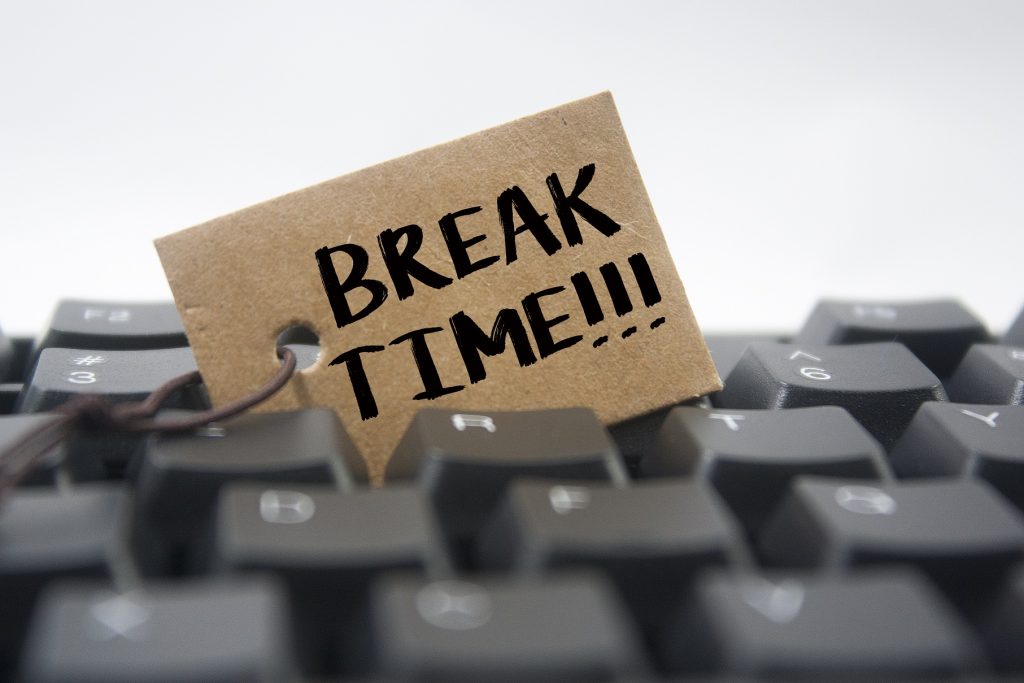How Effective Breaks at Work Increase Productivity

How much time do you allow for breaks during your team’s workday? Legally, during an eight-hour shift, employees are entitled to 30 minutes for lunch and two additional 15-minute breaks throughout the workday.
Many companies feel that this is enough time off during the day. However, workplace-centered studies are finding that breaks are important for employee productivity. This had led some companies to rethink sticking to minimum legal breaks at work and adding their own break policies.
Legal Breaks at Work: How Long Should They Be, And How Often?
Legal breaks at work must include one for 30 uninterrupted minutes and two additional 15-minute breaks during an eight-hour shift. Longer shifts will require additional breaks but employers and employees are realizing that this isn’t enough.
Performing repetitive tasks or sitting in one position for too long can take a toll on both the body and ability to focus. Mistakes can be easily made due to mental or physical fatigue whether sitting at a computer or running a machine. In some work environments, inattention, or lack of focus is a serious safety hazard.
Senior lecturer at MIT Sloan School of Management, Robert Pozen, recommends taking a break every 75 – 90 minutes for 15-minutes. There is a reason for the frequency of work breaks. The human brain has two modes, learning/focusing, and consolidation. Taking frequent working breaks helps the brain understand and retain information it recently processed.
Some studies by The Energy Project have found that people naturally go from full-focus to physiological fatigue approximately every 90 minutes.
Taking Breaks at Work Increases Productivity
Frequent breaks give the mind and body time to recharge. Here are some other benefits to working breaks:
- Accidents and injuries in the workplace due to inattention decrease
- Employee productivity significantly increases, resulting in a rise in company profits
- Posture due to prolonged work at a desk or machine can improve
- Employee morale increases
Taking breaks at work does increase productivity, even if machines and computers are idle for a few minutes. The short time away gives employees the chance to stretch tired muscles, find relief from sustained positions and postures and retain any information they might have learned in the last hour or so.
The short breaks also help employees refresh, and this will cut down on expensive workplace accidents. However, how employees spend their working breaks is as important as length and frequency.
How to Make The Most of Rest Breaks During Working Hours
As soon as break time hits, workers often rush to the vending machines and coffee pot. Their goal is to consume as much sugar and caffeine as possible before the end of their break for an energy boost. However, this won’t prevent fatigue before the next scheduled break – and will most likely result in a brief energy spike followed by an even bigger crash, with a series of negative consequences when this behavior becomes consistent. Breaks increase productivity, but not when spent like this.

Employers who want to maximize the effectiveness of breaks during working hours should consider encouraging their workforce to spend their free time on the job a little differently. The break room environment should be set up to be conducive to giving employees the needed chance to relax and rejuvenate.
Here are some ideas to consider:
- Create a meditation room. If there is space, creating a quiet place for employees to spend a few minutes relaxing and clearing their thoughts will have a dramatic effect on productivity.
- Replace junk food with healthy snacks in the vending machines. Some corporations have entered into agreements with local businesses to keep breakrooms and vending machines stocked with nutritious snacks. Healthy foods restore energy without the fatigue and irritability that are common side effects of sugar and caffeine.
- Organize afternoon exercise breaks. The afternoon, or half to two-thirds through a shift, is when workplace fatigue typically sets in the hardest. Exercise breaks bring a whole host of benefits for your team, and increased productivity is just one of them. (Read why Forbes pays their employees to take exercise breaks.) It can include everything from stretching exercises to jumping jacks or letting employees mingle and laugh together.
Take Advantage of Microbreaks
It’s not always possible to take 15-minute breaks throughout the day. When this is the case, take advantage of microbreaks, which can be anywhere from several minutes to several seconds. Microbreaks still provide a powerful opportunity to mentally or physically relax and reset before jumping back into your tasks. (No matter how many breaks are taken throughout the workday, a 20-second microbreak can work wonders for increasing productivity.)
What you do during your microbreak can vary depending on what position you’re in for most of the day, but in most cases, a great use of the time is to momentarily reset your posture. If your job calls for repetitive motions, spending a few minutes (or even seconds) stretching or moving through a counter-posture will help to readjust your body. A quick mental and physical reset can make all the difference for avoiding injuries or costly mistakes.
Make Work Breaks Work For You With Work-Fit
At Work-Fit, we specialize in allowing more frequent breaks than required by law may sound like productivity will be going down. However, the opposite is true. More frequent work breaks boost employee morale and productivity – especially when the breaks are high-quality breaks like meditation, exercise, or posture resets.
If your team spends the majority of their day in one position or engaged in heavily physical tasks, contact the professionals at Work-Fit to come up with an effective productivity-increasing and injury-reducing break plan.



